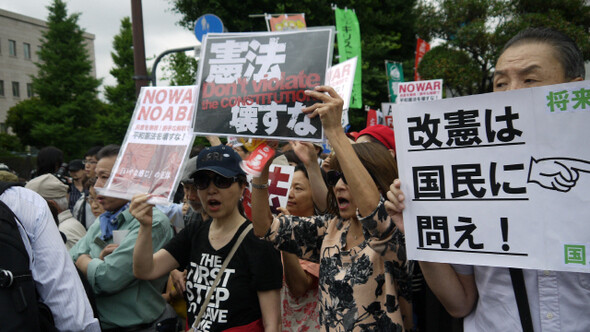hankyoreh
Links to other country sites 다른 나라 사이트 링크
Newly discovered letter indicates Japanese PM initiated renunciation of war, after WWII surrender

The heart of the current Constitution of Japan - the so-called “Peace Constitution” enacted in 1946 - lies in Article 9, which declares the country’s renunciation of war.
But right-wing forces in Japan, including Prime Minister Shinzo Abe, have repeatedly argued for the revision of Article 9, claiming it was imposed by the US as victors in World War II rather than chosen by Japan. The Tokyo Shimbun newspaper reported on Aug. 12 that new materials had been discovered suggesting that the article was first proposed to US military administration commander Douglas MacArthur by then-Prime Minister Kijuro Shidehara. Describing the new materials as a valuable piece of evidence refuting the right’s claims that Article 9 had been “imposed” by the US, the newspaper predicted they may influence discussions on a possible amendment of the Constitution as they gain momentum this fall.
According to the Tokyo Shimbun, University of Tokyo emeritus professor Teruhisa Horio uncovered a letter at the Japanese National Diet Library sent by MacArthur - onetime Supreme Commander for the Allied Powers (General Headquarters) - to then-Constitution Research Council chairman Kenzo Takayanagi. The letter clearly stated that the proposal to insert a provision banning war in the Constitution had been made by former Prime Minister Kijuro Shidehara.
The story is one that dates back to the 1950s, when Abe’s maternal grandfather Nobusuke Kishi - who advocated revising the Peace Constitution - was serving as Prime Minister. Kishi had been arrested after WWII as a Class A war criminal, but was able to make a political comeback thanks to a purge of communists in Japan, on the order of the General Headquarters of the Allied Forces. His belief was that the Peace Constitution should be revised to allow Japan to rearm itself. In 1957, he set up the Constitution Research Council to investigate the process of the current text’s enactment. As the council’s chairman, Takayanagi traveled to the US the following year and set MacArthur a letter inquiring about the process of Article 9’s inclusion.
In the text, Takayanagi asked whether Shidehara, who had been Prime Minister at the time of the Constitution’s enactment, had been the one to suggest adding a provision to the new draft banning war and the possession of weapons, or whether it had been recommended by MacArthur himself.
In his response to Takayanagi, MacArthur wrote that Shidehara had made the proposal.
“I was shocked at his proposal, but told him I agreed in my heart, and a look of definite relief came over his face. I was moved,” MacArthur wrote.
The question of who was first to propose Article 9 has been a consistent subject of debate in Japan. It’s a matter that relates to the complexities of the process by which the current Constitution emerged through negotiations with US under the military administration. The administration felt that Japan, having brought on the catastrophe of the Pacific War, should be prevented from starting wars again. But the first Constitution draft it presented after its defeat fell short of the administration authorities’ hopes with its acknowledgement of the country’s military. As guidelines for enactment, the administration suggested three principles thought up by MacArthur. Included among them was one reading, “War as a sovereign right of the nation is abolished. Japan renounces it as an instrumentality for settling disputes and even for preserving its own security.”
But with no clear knowledge of who was first to propose Article 9 renouncing war, the controversy has continued. In arguing to amend the Constitution, Abe has repeatedly said the article was “created by GHQ over an extremely short time.”
Horio, who located the letter in question, said its discovery means “any reason for denying that Prime Minister Shidehara suggested Article 9 has disappeared,” the Tokyo Shimbun reported.
By Cho Ki-won, staff reporter
Please direct questions or comments to [english@hani.co.kr]

Editorial・opinion
![[Column] Has Korea, too, crossed the Rubicon on China? [Column] Has Korea, too, crossed the Rubicon on China?](https://flexible.img.hani.co.kr/flexible/normal/500/300/imgdb/original/2024/0419/9317135153409185.jpg) [Column] Has Korea, too, crossed the Rubicon on China?
[Column] Has Korea, too, crossed the Rubicon on China?![[Correspondent’s column] In Japan’s alliance with US, echoes of its past alliances with UK [Correspondent’s column] In Japan’s alliance with US, echoes of its past alliances with UK](https://flexible.img.hani.co.kr/flexible/normal/500/300/imgdb/original/2024/0419/2317135166563519.jpg) [Correspondent’s column] In Japan’s alliance with US, echoes of its past alliances with UK
[Correspondent’s column] In Japan’s alliance with US, echoes of its past alliances with UK- [Editorial] Does Yoon think the Korean public is wrong?
- [Editorial] As it bolsters its alliance with US, Japan must be accountable for past
- [Guest essay] Amending the Constitution is Yoon’s key to leaving office in public’s good graces
- [Editorial] 10 years on, lessons of Sewol tragedy must never be forgotten
- [Column] A death blow to Korea’s prosecutor politics
- [Correspondent’s column] The US and the end of Japanese pacifism
- [Guest essay] How Korea turned its trainee doctors into monsters
- [Guest essay] As someone who helped forge Seoul-Moscow ties, their status today troubles me
Most viewed articles
- 1[Column] The clock is ticking for Korea’s first lady
- 2After 2 months of delayed, denied medical care, Koreans worry worst may be yet to come
- 3Hong Se-hwa, voice for tolerance whose memoir of exile touched a chord, dies at 76
- 4[Column] Has Korea, too, crossed the Rubicon on China?
- 5US overtakes China as Korea’s top export market, prompting trade sanction jitters
- 6Samsung barricades office as unionized workers strike for better conditions
- 7[Editorial] As it bolsters its alliance with US, Japan must be accountable for past
- 8[Correspondent’s column] In Japan’s alliance with US, echoes of its past alliances with UK
- 9All eyes on Xiaomi after it pulls off EV that Apple couldn’t
- 10[Correspondent’s column] The US and the end of Japanese pacifism